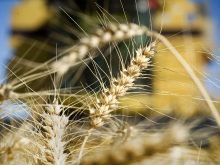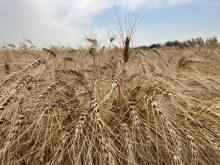Are the risks associated with planting before temperatures can support a crop worth potential benefits?
Plants need as much sunlight as possible to maximize photosynthesis. That has led some farmers to see if they can add to their sunny days by seeding earlier.
However, there’s a long-held belief that early seeding is too risky. If ambient temperatures and soil temperatures don’t rise quickly, the seed will sit and rot. If an early deep frost hits, young seedlings will freeze. That could mean a lot of loot lost on seed and diesel that never transforms into a viable crop.
On the positive side, when early seeding works it means early harvest and reduced odds of frost damage in the fall, hail and other risk factors. If ultra-early seeding works, it can also provide a grade benefit.
Read Also

VIDEO: Case IH reveals new Optum tractor at Agritechnica 2025
Case IH reveals its new Optum tractor at Agritechnica 2025.
Related stories in this issue:
If normal early seeding makes you a little uneasy, the concept of ultra-early seeding will make you downright nervous. Ultra-early simply means pushing the recommended temperatures well past their normal limits, all the way to February in some trials. And with soil temperatures at 0 C.
University of Alberta researcher Graham Collier has accumulated seven years of data probing the potential benefits and pitfalls of ultra-early seeding. Initial trials were conducted in 2015-19, with 40 site years across Alberta and Saskatchewan.
In fact, Collier was awarded his phD on the topic this winter. He is employed by Nufarm as portfolio manager for Canada.
Collier’s research team wasn’t sure if the genetics of a wheat seed could handle soil at colder temperatures. Would one variety work while many others wouldn’t? Would a seed and plant benefit from capturing more spring moisture and more days of sunlight? Would minimizing exposure to mid-summer heat stress improve the health of the wheat heads?
Collier says it’s about reducing the gap between potential yield and realized yield.
“We look at ways to synergize our management practices with the environment and with the genetics. The yield gap in Western Canada really isn’t too bad. If we’re doing the best job we can do, we can achieve about 70 to 80 percent of potential yield,” Collier said.
He said prairie soil zones have a potential yield of four to 6.5 tonnes of wheat per hectare. That’s about 60 to 100 bushels per acre. Now, prairie farmers are hitting up to 70 percent of that yield potential. He said that’s not too bad compared to a lot of places in the world.
The team based its work on an acronym G.E.M. for genetics, environment and management. Their first change in management tactics was the seeding date. They looked at three cold-tolerant lines of wheat, taking winter wheats and turning them into spring wheats they hoped would be hardy enough for the cold.
“We based seeding dates only on soil temperature. That’s key to this system. It’s not a calendar date so throw away your calendar. Spring comes at a different time every year. Forget about the weather forecasts.
“Some farmers wait to seed until there are buds on the trees. My grandpa always waited until he could hear the bullfrogs,” Collier said.
And so, with a complete disregard for traditional recommendations and conventional wisdom, Colliers team seeded plots at six different soil temperatures: 0 C, 2 C, 4 C, 6 C, 8 C and 10 C. Seeding depth was two inches. In spite of harsh spring air temperatures most years, the team did not lose a crop.
They concluded there was a yield peak in the 2 C, 4 C, 6 C and 8 C soil temperatures. Since a soil temperature of 10 C is about normal, that trial was not significant. At 0 C, the yield benefit was just slightly less than at 2 C.
Collier says they had the best yield peak between 2 C and 8 C soil temperature, which is probably quite a bit earlier than most farmers are willing to seed. They had more plants surviving at 0 C, 2 C, 4 C, and 6 C than they did holding off and waiting. He says this was completely unexpected.
“Our very greatest yields were always in the plots planted between 2 C and 6 C. Even in the 0 C plots, the yield was never worse than plots where we held off until 10 C. I’m quite comfortable recommending seeding in the 2 C to 6 C window. From there, the concept gradually blends into the normal recommended temperature range.
“But here’s the surprise. We had better plant survival in the ultra-early plots than in the later plots. We chalk that up to inter-species competition. The plants are coming out of the ground a little slower. More plants are establishing and producing more viable heads instead of fewer plants with more tillers.”
Collier says a farmer can only put in so much seed with ultra-early. If you’re putting in 2,000 acres of wheat and start at 2 C soil temperature, you could be up at 10 C before seeding is done. There’s no way to put all your wheat in at 2 C, but starting earlier and finishing earlier has a significant yield benefit.
“The sooner you get seed in the ground, the quicker the plants take advantage of those early growing degree days. You want to harvest as much sunlight as possible. You lose early growing degree days if you hold off seeding.
“The earliest we’ve planted was February 16, 2016, in Lethbridge. After the seed got in the ground, we had 37 nights with the temperature below 0 C. It survived. It came off a little earlier, with no loss of yield or protein.
“The important point is that you have a plant with more leaf area when summer solstice comes along. Plus, you’re filling grain a little earlier. When you get that really detrimental heat stress end of July and early August, your plant is more mature and better equipped to handle heat,” Collier said.
He points out that 30 days earlier seeding does not mean you get a 30 day earlier harvest. It might give you only 10 early days at the end of the growing season. But that 10 days is nothing to sneeze at. Having early crop on some fields lets you harvest them earlier, which reduces risk of frost, hail, wind, insects and other enemies. Early harvests often produce higher grade and they spread the workload.
Even if the ultra-early crop is ready to cut on the same day as the conventional recommended seeding, that 30-day jump means the crop had 30 extra days of sunlight energy to put into carbohydrate into that crop. The only plots where protein dropped slightly were the plots that had a higher yield. With the higher yield, those plots still ended up producing more protein.
Collier found that sometimes there’s frost on top of the soil. But below, the soil is holding a lot of heat. By the time that seed germinates, it’s warm enough that it will survive and take off growing. They observed this in Saskatchewan sites and all over Alberta from Lethbridge to Dawson Creek and into British Columbia.
“The system works a little better in the browns and dark brown soil zones. Winter snow cover disappears earlier in those regions and things warm up more slowly. If my planting trigger is 2 C, that might be March 1, for instance. I might not reach 10 C soil temperature until March 30.
“When you get into the black soils, the snow disappears a little later. You’ve got more sunlight and more energy going into that soil. So the period of time between 2 C and 10 C is much smaller. It might only be a week.
“Our natural assumption was that pushing the seeding date forward would expose the plants to more risk. In 40-site-year trials, we did not have a single plot that failed or was inferior to the control.
“We have a number of farmers trying this now in Alberta and Saskatchewan, and it seems to be working well for them.”
















